The concept of Rank-Size Rule or Rank-Size Distribution
The Rank-Size Rule was revealed in both developed and underdeveloped countries when the cumulative frequency of cities with a population of greater than twenty thousand people was ranked against the size of a city on a log-normal scale.
The distribution of city sizes in terms of population in both underdeveloped and developed countries has recently come under close examination by specialist in many academic fields and under settlement geography. The advent of general systems theory has proved to be an invaluable analytical approach to the study of city size distribution, in that it incorporates stochastic growth theory, and the concept of entropy. The two aspects of general systems theory have been very useful in explaining some of the empirical regularities observed of city size distribution, especially the rank size distribution.
For example: is there any significance in the fact that some cities have grown faster than other cities? What are the causes of his growth? What are the problems associated with differential growth and size of cities?
Much of the work on urban problem has been done in relation to regional development programming in the United States and comparatively little research has been undertaken on the fundamental problems of defining an optimum size distribution of cities for developing countries. Any criteria for optimum population size involves implicitly and explicitly two elements: first the normative element, which places a positive or negative valuation in a particular situation and second a factual element which has the force of the statement of empirical relationships between variation in city size and variation in situation question.
Related: Primate City & Primacy | Relationship between city sizes
Among the criteria that have been examined in relation to the optimum city size in both developed and developing countries is: (World Bank no longer used the term Developing & Developed Countries)
- City size and physical planning of cities with respect to the frequent demand that cities be small enough to enable ready access to the countryside and a reasonably moderate journey to work, i.e. transport problems.
- City size and health (mortality rate, incidence of disease etc).
- City size and public safety (crime rates, accident rates, fire hazards etc).
- City size and municipal efficiency.
- City size and education expenditure.
- City size and cost of living.
- City size and public recreation
- City size and retail facilities
- City size and family life.
- City size and miscellaneous psychological and social characteristics of urban life (community participation, social contentment).
- City size and associations.
Factors affecting the Rank Size Rule
The factors like administrative organization, transportation linkages, industrial development and commercial spread play a major role in changing the rank-size relationship. The disproportionate development of these facilities causes variation in the centripetal forces involved in the growth of the settlements.
The population change in a centre within a certain time interval also changes the rank of a centre. The rank of any centre is dependent upon the hierarchical arrangement of the nodality value – which may be population size or an index based on different functions available at a place. The latter may depend upon the provision of administrative and transport facilities and the development of commerce and industry. The dissimilar and disproportionate development of these facilities causes variation in the centripetal forces involved in the growth of urban places.
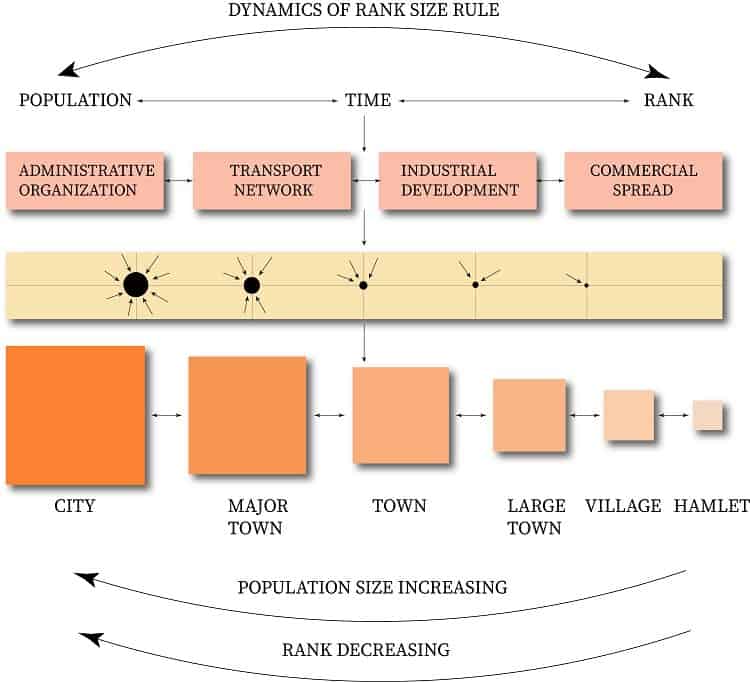
This concept of close proximity has, however, changed today with the introduction of quick, mechanized transport, for example, people generally move from one village to another on foot which involves certain amount of time. The smaller enjoys the facility of buses so that the inhabitants can also move from one centre to another more quickly. The bigger towns have train facility for travel between them. The development of airways has connected one city level centre to another. Hence, travel by the various above means though involving money, does not consume much more time than the movement from one village to another on foot. The shows the expansion in the zone of influence and spatial pattern of an urban centre based on transport facilities, which also control the rank and number of different order of urban places. The larger centres are more widely spaced and are, therefore, fewer in number while the small towns are larger in number and more closely spaced. The regularity has proved that as the nodality/centrality of places increases, the number or urban places decreased according to the rank-size rule.
Dynamics of Rank Size Rule
The contribution of rank size rule in regional planning
- It helps in the interpretation of the relationship between rank and population size of settlements.
- It helps in analyzing the settlement networks.
- It explains settlements with respect to economic activities as increase in activities increase the population size.
- It explains the imbalance between the settlements due to rapid growth in population or activities.
Rank-Size Rule And Developing Countries
The most complete and comprehensive empirical study of the rank-size rule in developed and developing countries is that by Berry who analyzed city size distributions and their relationship to economic development in thirty-eight countries. He found that the distributions fall into two major categories namely the Rank Size Distribution and the Primate Distribution.
The Rank-Size Rule was revealed in both developed and underdeveloped countries when the cumulative frequency of cities with a population of greater than twenty thousand people was ranked against the size of a city on a log-normal scale. Thirteen of the thirty-eight countries had log-normally distributed sizes.
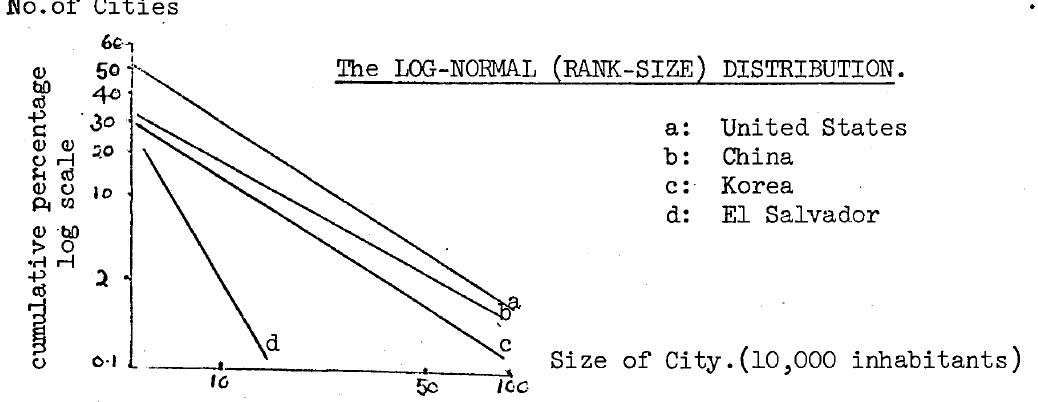
The primate distribution which was characteristics of fifteen out of thirty-eight countries examined is observed, when a stratum of small towns and cities is dominated by one or more very large cities and there are deficiencies in the number of cities of intermediate size. Berry study tended to support the hypothesis that Primate City Distributions are associated with over-urbanization and superimposed colonial economies in underdeveloped countries or with political administrative controls in indigenous subsistence and peasant economies. Furthermore it has been argued that primate cities have paralytic effects upon the development of smaller urban places and tend to be parasitic in relation to the remainder of the national economy.
Related: Rural urban fringe: Concept, History, Reasons, Issues
Nine out of thirty-eight countries examined had distributions intermediate between log-normal (rank size) and the primate distribution.
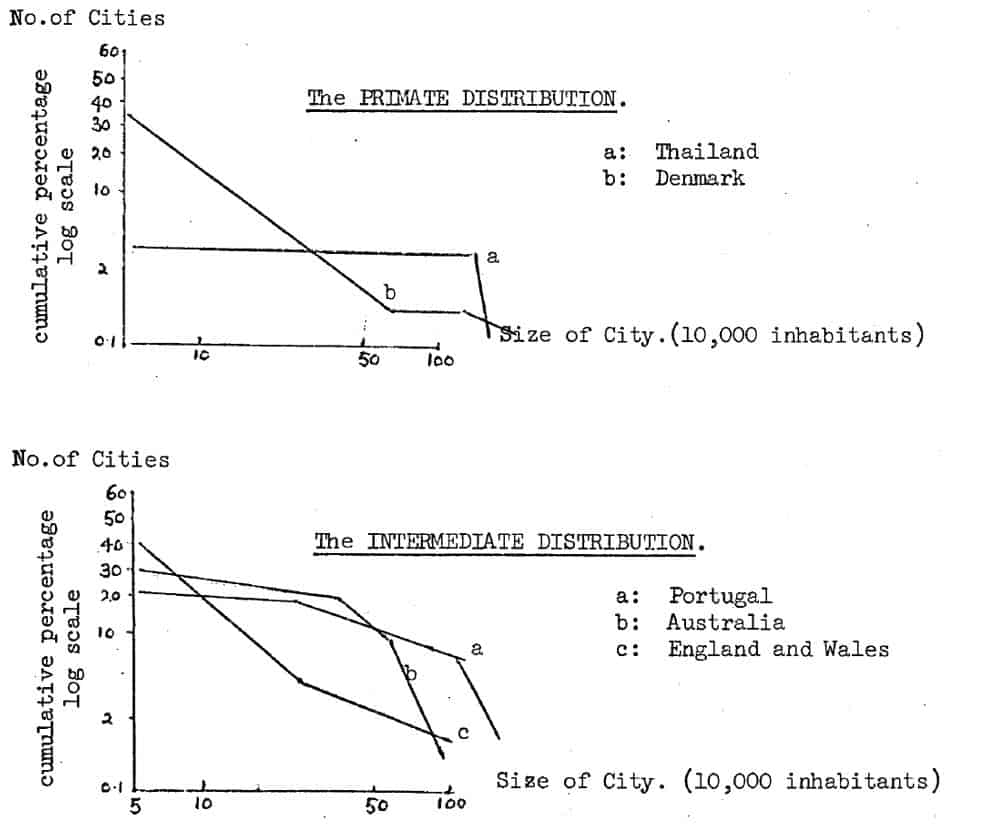
The Rank-Size Rule
The rank-size rule says that ‘when ranks of cities, arranged in descending order, are plotted against their populations (rank 1 being given to the largest, and so on) in a doubly logarithmic graph, a rank-size distribution results’ (Das and Dutt 1993: 125), or to put it in much simpler words: ‘In an ordered set of cities representing a given country, the product of the rank and size of a city is constant’ (Dziewonski 1972: 73). The rank-size rule is also commonly referred to as Zipf’s Law because the model describing a constant relation between the size of an event and its rank was at first developed by G. Zipf. In the case of cities distribution by population, when the natural logarithms of the rank and of the city size (in terms of the number of people) are calculated and represented graphically, a remarkable log-linear pattern is attained, which is called the rank-size distribution. If the slope of the line is equal or close to -1 (a straight line), the relationship is known as Zipf’s Law.
Zipf’s has probably the best presentation of the empirical findings on rank and size of the cities. The rank size rule states that for a group of cities, usually those exceeding some size in a particular country, the relationship between size and rank of cities is given by:
Pr = P1/r
Where Pr = population of the largest city ranked r
P = population of the largest city
r = rank of city r
Rank Size Rule is a simple model which states that population size of a given city tends to be equal to the population of the largest city divided by the rank of the given city.
Pattern as per rank-size rule
Settlements in a country may be ranked in order of their size. The ‘rule’ states that, if the population of a town is multiplied by its rank, the sum will equal the population of the highest ranked city. In other words, the population of a town ranked n will be 1/nth of the size of the largest city—the fifth town, by rank, will have a population one-fifth of the first.
It is usually possible to relate the ranks and sizes of the central places in country by using a regression analysis
log Pk = log P1 – b log k
where P1 is the population of the largest city or town, Pk is the population of the kth town by rank, and b is a coefficient which must be established empirically for each investigation. The greater the value of b, the steeper the slope, and the greater the primacy of the largest city or town. Many developing countries show a sharp fall from the largest, primate city to the other cities, and this is known as the primate rule.
The theoretical rank size rule pattern is a straight line.
In urban primacy, a single city dominates and is much greater than the next large center (primary pattern).
In Binary pattern two or more cities are larger than the predicted size.
In Stepped order pattern there are series of levels and steps (conurbations, cities, towns etc.).
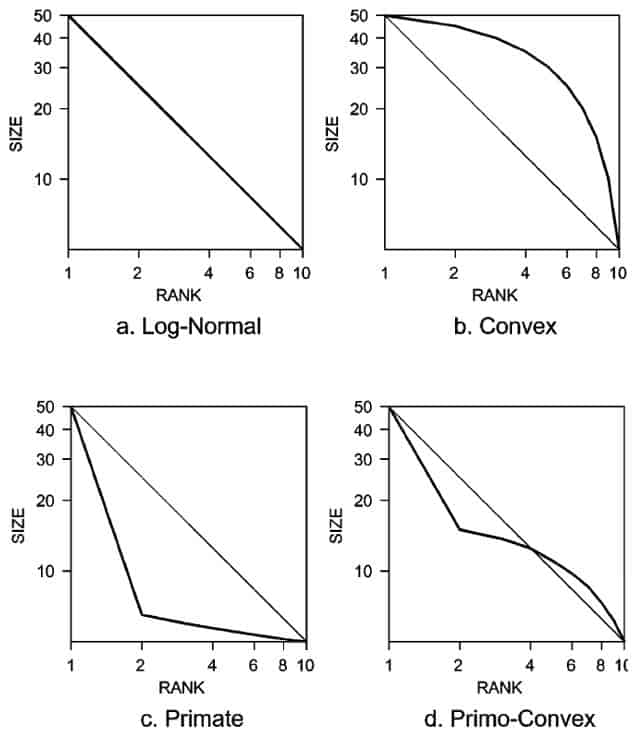
Related: Burgess model or concentric zone model
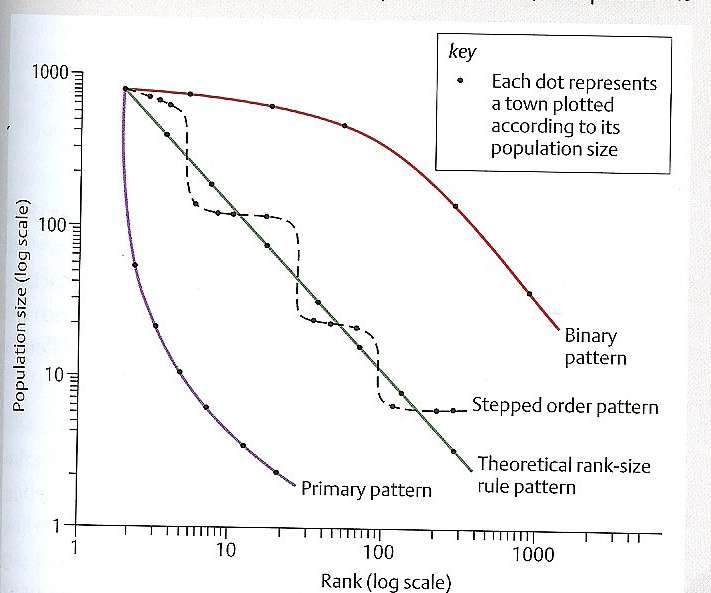
Rank-size rule analysis and ancient cities
The Rank Size Rule applies to the modern cities but when we try to apply the same law to the older cities we face difficulty in correlating the theory. The geographers try to correlate the data with the population datum which we don’t have in case of ancient cities and ancient city were characterized by city walls or fortifications but the settlement was never within the city walls, it always exceeded. The population of the city will depend on the city area. A larger city will have larger population.
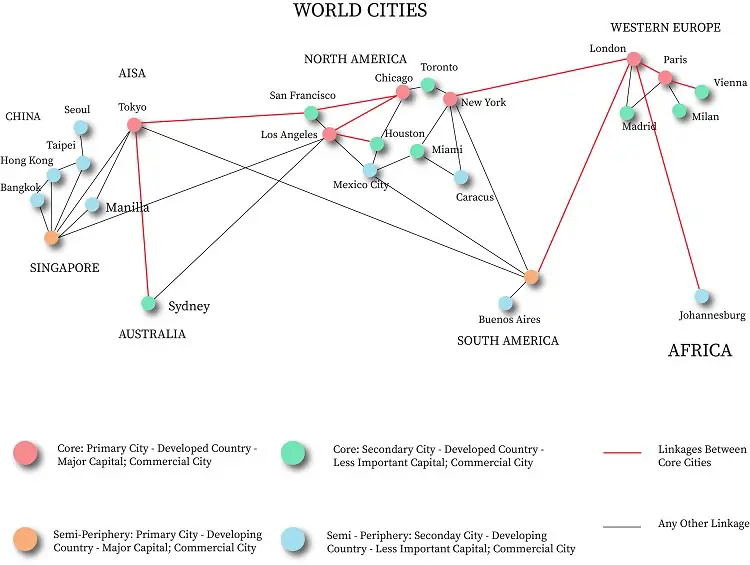
Related: Central Place Theory (CPT) by Walter Christaller (1933)